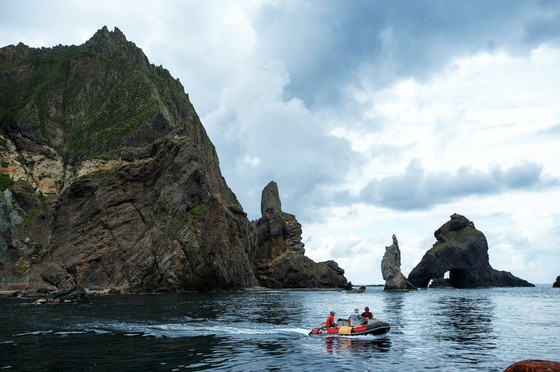 |
The aspect of the subsequent development is summarized as "China's offensive vs. Japan's unresponsiveness". The news that Chinese patrol boats and reconnaissance planes have invaded the Senkaku Islands is no longer unfamiliar.
Japan only maintains a "calm mode" to deal with this to the minimum necessary. China embarked on physical action, recognizing the reality that adherence to the "pending unresolved" policy means the de facto permanent abandonment of the Senkaku Islands from the standpoint of China, which cannot effectively control it. The intention is to break through the current situation by stimulating the other party and maximizing the conflict issue. From the standpoint of China, which cannot control effectively, it is a very rational and correct choice.
Japan, which effectively controls the Senkaku Islands, is in the process of detecting the intentions of such opponents and maintaining a non-responsive strategy. If you counter the provocation one by one, you will be swayed by China's intentions, stimulate up to 1.4 billion ordinary Chinese people, there is no real benefit, and it will only be a burden in various fields such as politics and economy.
From this aspect, the aspect of "China's offensive vs. Japan's unresponsiveness" developed for the Senkaku Islands seems to be a rational choice made under their own strategic calculations. With such an equivalent composition of "rational choice vs. rational choice", the effective control side is naturally advantageous.
China's original expectation was the development of "China's offensive vs. Japan's opposition" that is, "rational choice vs. irrational choice" and Japan was not involved in this.
Dokdo (Japanese name: Takeshima) is effectively controlled by South Korea. It is in a territorial dispute with Japan. Many Koreans say that Dokdo is in a territorial dispute and cannot be admitted. However, if the other party presents some grounds and continues to claim sovereignty, in this case, a sovereignty dispute will be established regardless of our desire.
If you try to resolve a territorial dispute, you can logically neutralize the other party's claim, or you can say that the other party is no more than that through the judgment of a publicly credible institution (ICJ: International Court of Justice, etc.) The only way is to get rid of it.
However, South Korea cannot completely control Japan's claim, and at the same time, they avoid going to ICJ. Old maps and literature that support Dokdo as Korean territory are reported in the Korean media from time to time. However, this situation is the same on the Japanese side. The following is an example of Japanese media coverage.
Shimane Prefecture announced on the 21st that it has confirmed five points on a map of the late Edo period that displayed Takeshima as Japanese territory. Two of these, "Complete map of Ezo customs and humanity," and "Complete map of Ezo Soshi," were produced in 1790 by the explorer "Mogami Tokunai," who worked as a surveying assistant in the "Ezochi Survey Team" of the Shogunate. Shimane Prefecture revealed that it was "a valuable document showing that the recognition that Takeshima was Japanese territory was widespread, including the Shogunate." The other three points are the "Northern Map of Japan", the "Kansei Asia Map" (1796), and the "List of Huayuan" (1806). Shimane Prefecture has revealed that the "Takeshima Problem Study Group" has investigated and confirmed museums in various places. The "Complete Map of Ezo Soshi" does not have the name of the island on the northwest side of the Oki Islands, but "Takeshima" is drawn and painted in the same red (brown) as the mainland. Two points, such as the "Northern Map of Japan," have the notation "Matsushima (currently Takeshima)" and "Takeshima (currently Ulleungdo, South Korea)" on the two islands, and are colored in the same red color as the mainland. The islands are also classified as Japanese territory by describing "bamboo island" and "pine island" in the "Sinocentric list". (Omitted, January 21, 2014 "Yomiuri Shimbun")
Regarding Takeshima (Oki Island Town, Shimane Prefecture), which is illegally occupied by South Korea, Shimane Prefecture announced on the 17th that it has found materials that concretely show the situation of seal hunting that was being carried out around 1897. bottom. A relative of a person engaged in hunting wrote it down in 1977. It is said that hunting and fishing were carried out in the surrounding area before the government decided to incorporate Takeshima into the territory in 1905, and the prefecture said, "The process of establishing territorial rights by Japan. It is a valuable reinforcing material for explanation. " (Omitted, February 17th, 2017 "Sankei Shimbun")
The dispute between Korea and Japan over Dokdo is therefore not a situation in which one of them is blinded by territorial greed and is forced to do so, but rather a situation in which they confront each other with their own favorable evidence. Is just right.
The point is still "effective control". In the past, the Japanese government acknowledged "effective control of South Korea" and inwardly said, "Physical occupation is impossible, but physically and nominally, there is no choice but to continue claiming sovereignty. You will understand. "
This can be understood only by the fact that during this period, Japan only claimed sovereignty in words and never threatened by mobilizing physical forces such as warships.
After the Korea-Japan Agreement in 1965, Korea and Japan stayed safe with Dokdo, effectively adhering to the "pending unresolved" principle. On the Korean side, which has effective control, the continuation of such an "unresolved pending" state was seen as a "judgment win" against Japan, and at the same time, a happy situation that must be "complete ownership of Dokdo." ..
However, South Korea itself kicked off such an advantageous situation first. In 1997, President Kim Young-sam broke such an implicit agreement between the two countries and built a ship berthing facility and a breakwater on Dokdo in an electric shock. With this as an opportunity, the Korea-Japan Dokdo sovereignty dispute began in earnest.
In 2006, when President Roh Moo-hyun, he received a great deal of opposition from Japan by attempting to register a Korean-style name for the waters around Dokdo through the International Hydrographic Organization (IHO). Going further, South Korea declared "opening Dokdo" to Koreans and foreigners from this time, allowing anyone who was approved to visit Dokdo.
After that, various anti-Japanese performances by entertainers were held on Dokdo, and various events such as youth exploration, taekwondo performances, Hanbok fashion shows, and Go competitions lined up.
Live-fire training was also carried out, and it was even used as a stage for the hurray of parliamentarians. After all, Dokdo became a hot issue between Korea and Japan at the same time as it led to the president's visit.
After the repulsion, Japan strengthened Dokdo (Takeshima) sovereignty claims in various textbooks, created an event called "Takeshima Day" in 2006, and then increased the scale of the event every year. Is going.
In 2006, the US Ambassador to Japan, "Thomas Schieffer," sent a telegram to the US State Department and others regarding the Korea-Japan conflict with Dokdo.
"Japan is exercising its rights within the limits of international law. On the other hand, South Korea is acting irrationally. South Korea is doing something crazy and has serious problems. It is worrisome that it will cause. Both sides should step back for a peaceful solution to the problem. "
At the same time as this conflict between Korea and Japan continued, many Japanese people who were indifferent to Dokdo gradually became interested in Dokdo. Then, public opinion such as "Korea is such a fuss, but what is the Japanese government doing?" Has begun to form in Japan.
The Japanese government was gradually forced into a situation where it had to show something to its own people. Dokdo's appearance on the map of the Tokyo Olympics seems to be a result of the distress of the Japanese government.
If so, what has South Korea gained so far in the Dokdo confrontation with Japan?
In a word, there is nothing. Nothing has been gained because of the effective control state, and nothing will be gained in the future.
What did you lose?
I've lost so much that I can't even list it. Not only the direct damages such as tourists from Japan, which began to decrease sharply due to the president's visit to Dokdo, and the fishery agreement that was stuck for 6 years, but also the invisible damage fields and the spread of damages, the scale is It will be beyond imagination.
By the way, it would be fortunate if the current effective control situation could be maintained safely even after suffering such damage. Unfortunately, even this can be a trivial matter, given the increasingly chilly airflow in Japan.
I hope that it is a shame, but in the current situation where the worst Korea-Japan relations continue, it is said that a hardliner against South Korea will be appointed as the next or next prime minister of Japan. Then, I don't know where the situation will be scattered.
With the support of public opinion in Japan, which wants even stronger measures regarding territorial rights, Japan should see the potential for Dokdo as open as China does for the Senkaku Islands.
Koreans are not at all grateful that Dokdo is in conflict with Japan, not China. If the other party were China, what would Dokdo look like now?
It may have come this far because Japan is easy for the other party to give. However, it seems that "Japan that is easy to give" has now begun to change 180 degrees. "Happiness" is not noticed at that time, but it is a good idea to notice it only later.
If the Korea-Japan conflict with Dokdo becomes even more intense, the Dokdo issue may become semi-forced, just as the uncontrollable United States arbitrated the comfort women issue. If that happens, only South Korea will lose.
What can South Korea, which has effective control over, get against the useless and former Japan? Who can guarantee that the United States, which has reached its peak of fatigue, will not strongly recommend the following, while at the same time applying some kind of pressure that South Korea is hard to refuse in order to solve the situation fundamentally? ??
"Let's leave it to the International Court of Justice to make a conclusion. If you don't like the trial, let's fairly concede the eastern island of Dokdo, which is closer to the Japanese side, to Japan and end the conflict."
The current Dokdo territorial dispute between Korea and Japan is one of the many cases of territorial disputes in the east and west of ancient times. It will be recorded as a rare case.
In the end, the Koreans' persistent anti-Japan made them kick off the previous decision-winning situation (“unresolved hold”) that said “Korea's unresponsiveness vs. Japan's unresponsiveness”, and the other party hoped so much. I have created a composition of "Korean offensive vs. Japan's opposition", that is, "Korea's irrational choice vs. Japan's rational choice".
If you're stupid, you can't seem to keep the territory you've got.
2021/09/25 21:07 KST


